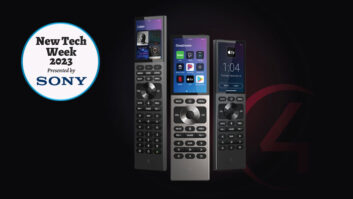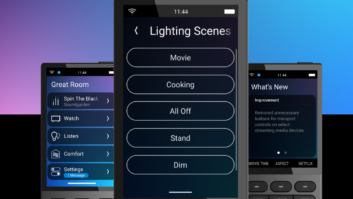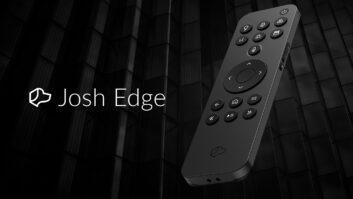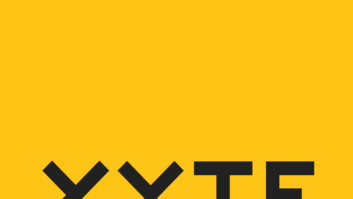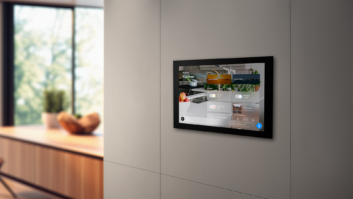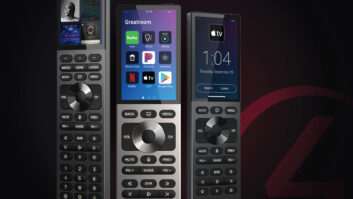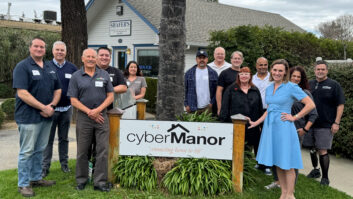A sexy body, sleek appearance, and top performance used to be enough to provide the ultimate in satisfaction. But remote control manufacturers are finding that while those qualities are still in demand, customers are now expecting their remotes to also look and act like today’s latest electronic devices.
“Consumers want their iPods and iPhones to act like remote controllers and they also want their touchpanels to act like iPhones,” Crestron marketing communications director Jeff Singer observed.

Crestron’s TPMC-3X handheld WiFi touchpanel combines the lightweight feel of a handheld remote with the interactive, graphical experience of a touchpan
Universal Electronics’ custom electronics product manager Patrick Serrato concurred. “With the number of color touchscreen consumer electronic devices in the market, end users are craving this type of functionality,” he said. “But it is our challenge to maintain a balance between advantaged color touchscreen controls and the familiarity of tried-and-true hard-button operation.”
AVOIDING OBSOLESCENCE
Keeping up with the speed of technological advancements in itself presents a challenge for manufacturers of remote controls. According to Mike Everett, general manager of RTI’s Pro Control division, it’s more difficult today to engineer products, because parts become obsolete much more quickly than in the past.
“The life cycle for some parts, like an LCD screen, may be measured in months, where it used to be measured in years,” he said. “A remote might have to be re-engineered if the parts we planned to use become obsolete before the product is finished.”
From gestures to touchpanels to touchscreens to total integration, residential electronic systems contractors are seeing a strong demand among their customers for more performance from the remote controls. And the manufacturers are doing their best to deliver.

RTI’s T1B

UEI’s NevoC2 and NevoC3 controllers were specifically designed to bring features such as activity-based macros and Favorite Channel buttons to a costeffective color touchscreen controller solution.
CRESTRON’S TPMC-3X
Crestron’s TPMC-3X handheld WiFi touchpanel combines the lightweight feel of a handheld remote with the interactive, graphical experience of a touchpanel. It offers custom touchpanel versatility through a 2.8-in. active-matrix touchscreen displaying 16-bit color graphics and video. Crestron’s exclusive DNav and Synapse technologies support gestures or swiping navigation.
The 17 large, widely spaced pushbuttons help to eliminate undesired button presses. And an electroluminescent backlit button text function helps to improve visibility when used in a darkened room.
It also features a five-way navigation pad, three context-assignable “hard keys” beneath the touchscreen, a thumb-operated “More” button for advancing through the available touchscreen pages, and a system power button.
“We engineered our own WiFi gateway and Windows embedded OS to enhance the performance of the TPMC- 3X,” Singer said. “Extended range and omni-directional communication enable roaming between gateways for whole house control from a single remote.”
UEI’S NEVOC2 AND NEVOC3
According to Serrato, one thing that does remain constant is that dealers like to provide unique control solutions for their clients at the best possible price. UEI’s NevoC2/NevoC3 controllers were specifically designed to bring features such as activity-based macros and Favorite Channel buttons to a cost-effective color touchscreen controller solution.

URC’s MX-5000 (left) is a two-way, wand-style, touchscreen color LCD WiFi IR/RF remote control, and the the MX-450 (right) was designed in response to installers who said they disliked Internet-based programming but did not want to do the programming on their PCs either.
Both products are the result of several years of research from the UEI inhouse industrial design team. The NevoC2 and NevoC3 each control up to 18 devices and have 41 programmable hard keys and four preset keys. The controllers look different from earlier Nevo controllers because they are based on a new design language that will be used for future Nevo controllers, with the goal of maintaining a balance between usability and style.
URC’S MX-5000 AND MX-450
“Hold an MX-5000 in your hand and you’re in control of a whole new experience,” URC director of marketing Jon Sienkiewicz said. “Not only does its vibrating ‘haptic’ feedback confirm button presses on the touchscreen, but its overall touch-and-feel is unlike that of any other remote we’ve encountered.”
The MX-5000 is a two-way, wand-style, touchscreen color LCD WiFi IR/RF remote control. It embodies all of the major features of the MX-6000, including IP control of many IP-based components. It is PC programmable (using CCP, URC’s universal programming platform) and sports a customizable GUI on a 2.7-inch color LCD touchscreen. The MX-5000 integrates AV control, lighting (URC Lighting Control by Lutron), PSX-2 Personal Server, HVAC, Windows Media Center PC, and other whole-house devices
According to Sienkiewicz, the MX-450, a wand-style, IR/RF standalone (non-PC programmable) hard-button remote control with color LCD, was designed specifically in response to installers who said they disliked Internet-based programming but did not want to do the programming on their PCs either. URC did preserve on-screen macro editing, so that programs can be adjusted without starting over again from scratch.
RTI’S T1-B AND ST-7
”We are constantly working to raise the bar and improve and augment our product offering with best-in-class feature sets and the sleek, sexy look that consumers crave, all at a great value,” RTI’s VP of sales and marketing Pete Baker said. The T1-B was influenced by RTI’s European partners, who were looking for an entry-level alternative to touchscreen remotes, while still offering powerful, elegant, and intuitive control. For example, the T1-B is completely customizable to any system, with 40 assignable keypad buttons that can be individually programmed. RTI’s soon-to-be-released ST-7 universal system controller will offer different in-wall or desktop docking options and feature a fully customizable seven-inch widescreen LCD display with a multi-touch capacitive touchscreen, integrated trackball for navigation and control, wireless ZigBee technology to provide two-way feedback with controlled devices, and built-in 802.11b/g wireless ethernet and web browser.

As with all Philips Pronto panels, the TSU9300 is IP based with WiFi control.
PHILIPS PRONTO’S TSU9300
As with all Philips Pronto panels, the TSU9300 is IP based with WiFi control. New, however, is a way to copy objects like buttons and backgrounds from one page to another by using the multiple-page view.
“This new feature lets you open as many pages as you like, offering a great overview of your project,” Philips Pronto senior product manager Dick Mol said. “In combination with the wizard using standard templates this allows one to create a control solution with a dedicated user interface in an instant.”
Two-way media and lighting control is possible for various brands, including Escient, Imerge, MCE PC, and Lutron. The rotary wheel offers control similar to an iPod and is programmable to control anything from the AV receiver volume to lighting levels.

Pro Control’s PRO- 24.z remote features a color OLED touchscreen display capable of controlling components via 433-MHz RF.
“When properly programmed, the TSU9300 is very easy to use thanks to activity-based design,” Mol said. “The installer can quickly create any user interface design and control functionality with the ProntoEdit- Professional software.”
PRO CONTROL’S PRO-24.Z AND PRO-24.I
Pro Control’s new product line is expected to begin shipping in Q3 2010, and will include the PRO-24.z and the cost-effective PRO-24.i remote.
“The PRO24.z is the first remote control to feature an OLED (organic light emitting diode) display. OLED displays are typically used in televisions, PDAs, and cell phones,” Everett said. “The incorporation of OLED technology allows Pro Control remotes to display deep black levels, draw far less power for improved battery life, and employ a much thinner and lighter LCD panel.”
Everett added that anyone who is familiar with RTI’s Integration Designer programming platform would recognize similarities. The wizardbased programming software will enable installers to support a variety of needs, such as basic IR control of the television, or complete feedback from an iPod, HVAC thermostat, lighting and security system.
